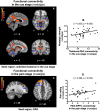Thalamocortical Mechanisms for Nostalgia-Induced Analgesia
- PMID: 35232762
- PMCID: PMC8985854
- DOI: 10.1523/JNEUROSCI.2123-21.2022
Thalamocortical Mechanisms for Nostalgia-Induced Analgesia
Abstract
As a predominately positive emotion, nostalgia serves various adaptive functions, including a recently revealed analgesic effect. The current fMRI study aimed to explore the neural mechanisms underlying the nostalgia-induced analgesic effect on noxious thermal stimuli of different intensities. Human participants' (males and females) behavior results showed that the nostalgia paradigm significantly reduced participants' perception of pain, particularly at low pain intensities. fMRI analysis revealed that analgesia was related to decreased brain activity in pain-related brain regions, including the lingual and parahippocampal gyrus. Notably, anterior thalamic activation during the nostalgia stage predicted posterior parietal thalamus activation during the pain stage, suggesting that the thalamus might play a key role as a central functional linkage in the analgesic effect. Moreover, while thalamus-PAG functional connectivity was found to be related to nostalgic strength, periaqueductal gray-dorsolateral prefrontal cortex (PAG-dlPFC) functional connectivity was found to be associated with pain perception, suggesting possible analgesic modulatory pathways. These findings demonstrate the analgesic effect of nostalgia and, more importantly, shed light on its neural mechanism.SIGNIFICANCE STATEMENT Nostalgia is known to reduce individuals' perception of physical pain. The underlying brain mechanisms, however, are unclear. Our study found that the thalamus plays a key role as a functional linkage between nostalgia and pain, suggesting a possible analgesic modulatory mechanism of nostalgia. These findings have implications for the underlying brain mechanisms of psychological analgesia.
Keywords: PAG; analgesia; nostalgia; pain; thalamus.
Copyright © 2022 Zhang (张明) et al.
Figures







References
-
- Andersson J, Jenkinson M, Smith S (2007a) Non-linear optimization. In: FMRIB technical report TR07JA1. Univ Oxf FMRIB Cent Oxf UK.
-
- Andersson JL, Jenkinson M, Smith S (2007b) Non-linear registration aka spatial normalisation. In: FMRIB technical report TR07JA2. Univ Oxf FMRIB Cent Oxf UK.
-
- Apaolaza-Ibantilde V, Mark Z, Hartmann P (2010) Memory, emotions and rock n roll: the influence of music in advertising, on brand and endorser perception. Afr J Bus Manag 4:3805–3816.
Publication types
MeSH terms
Substances
LinkOut - more resources
Full Text Sources
Research Materials
